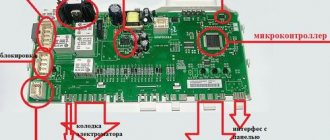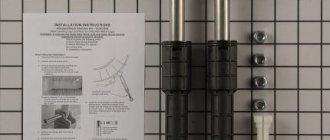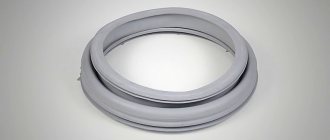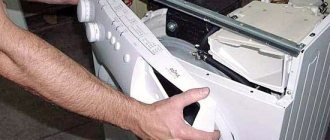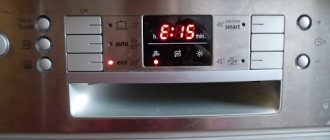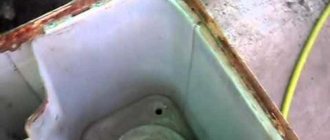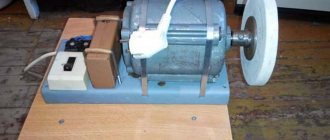Once upon a time, a washing machine was a luxury item, but today it is a common and necessary equipment in every home. Washing bedding, clothes or just socks in a washing machine has long become the norm. Therefore, the sudden breakdown of this assistant is immediately felt by all family members. As a rule, in such a situation, it is customary to call a repairman, he will fix the machine, and the client will pay a lot of money.
But there is an alternative - self-repair. This may seem unrealistic to some, because a modern washing machine seems like a very complex device with a huge amount of electronics. But if you understand how the machine works and what it consists of, then the problem will not seem so bad. And the videos below will help you repair your washing machine yourself.
The structure of the washing machine and the principle of its operation
To repair a device, you need to know the name of the parts and their purpose.
Units and parts of equipment:
- WPS sensors and valves - protect against leaks;
- WCS valve and sensor - keeps the volume of liquid poured into the tank under control;
- counterweights - reduce vibrations of the washing machine (presented in the form of weights that are attached to the top and bottom of the tank);
- shock absorbers and suspension springs are also necessary to dampen the vibration of the device;
- siphon - a hydraulic valve located in the drain hose;
- imbalance sensor - controls the rotation of the drum so that the laundry does not bunch up;
- ball valve - designed to open and close the drain hose;
- drain filter - retains small objects, fibers, and hair that fall into the water during washing, protects the drain pump from small objects.
Washing machine operation algorithm
The device works according to the following principle:
- The user loads laundry, selects a washing mode and starts the device. Then the electromagnetic lock closes, the loading hatch is blocked, after which the washing begins.
- The inlet valve opens, after which water begins to flow through the powder tray.
- As soon as the water reaches the required level, the sensor gives a signal and the inlet valve closes.
- The heating element turns on, heating the water to the set temperature (it depends on the selected washing program). After this, the temperature sensor sends a signal to the control module to heat the water, and the heating element turns off. Simultaneously with heating the water, a drum operates, which slowly rotates the laundry for uniform heating and wetting.
- When heating ends, the washing process itself begins. The drum specifically rotates in different directions to prevent laundry from bunching up into lumps.
- At the end of the wash, the drum stops rotating, and dirty water goes through the pump to drain into the sewer.
- Clean water is poured in (it no longer heats up) for rinsing. This process takes less time. The rinsing process ends by draining the water into the sewer.
- Then the drum begins to actively rotate, squeezing out the laundry. The pump is constantly running to pump out liquid. (On almost all models of washing machines, you can independently set the spin intensity or turn it off completely).
- After spinning, the drum stops and the loading hatch lock is turned off. The wash ends.
The drum does not spin
To find the reason why the drum does not spin in the washing machine, you need to:
- Check the selected mode; perhaps the washing program includes a pause.
- Inspect the drive belt. It probably came off or was stretched. To check the tension level, press the belt. Its displacement should be approximately 12 mm. If your washing machine is equipped with a tensioner, loosen or tighten the belt to the desired level. In cases where such a design is not provided, the only way out of the situation is to replace the belt.
- Pull the loading hatch door. If the latch is broken or jammed and the door does not close tightly, the drum will not work. Open the door and close it sharply again, pressing firmly. If all else fails, the lock is broken and requires replacement.
- Ring the electric motor. It is likely that it burned out.
The most common errors, their causes and how to fix them yourself
The machine does not turn on
There can be many reasons: from the most basic to electronic failures. First of all, you need to check the following points:
- Is the power cord plugged into the outlet?
- Is the door tightly closed?
- Is the streaking mode selected correctly?
In other cases, the reason lies in programming. After turning on, you need to pay attention to the control panel indicators and display (they should light up). If this does not happen, the problem may be a lack of input voltage.
First you need to check the voltage using a multimeter. If the outlet is live, you should check the entire power supply circuit. Be sure to check the machine switch and power cord, as well as the terminals (to do this, remove the top panel of the machine). Oxidized terminals must be cleaned.
When all the indicators turn on, but the wash still does not start, the reason may be a lack of water. Sometimes the inlet hose becomes pinched or the inlet valves are blocked. After testing the water, it is worth inspecting the mechanical time relay. If it malfunctions, the equipment does not start the washing program.
Water does not enter the drum or is drawn slowly
In addition to a blocked valve and a pinched inlet blank, there are a number of other reasons for the lack of water in the drum:
- Reduced water pressure in water pipes.
- The inlet hose or inlet filter is clogged. Before cleaning these parts, you must turn off the water supply valve. The hose is disconnected from the entire structure and cleaned using a special cable. After this, take out the filter and clean it under a powerful stream of water. The parts are assembled in reverse order.
- The inlet valve is broken. The problem will be solved only by replacing the part.
- The sensor responsible for regulating the water supply does not function. Usually the malfunction is explained by a clogged tube or oxidation of the contacts. If after the described steps the sensor does not work, it will have to be replaced.
The water in the drum does not heat up
Most often, this breakdown is not immediately detected. The machine behaves in the usual way: it turns on the washing, rinsing and spinning mode. After that, you take out the washed clothes, not even realizing that everything happened in cold water.
To check if the water is heating up, touch the appliance door during an active wash cycle. It should become warm under the influence of hot water. The main reasons for cold water supply:
- heating element malfunction;
- thermostat malfunctions;
- the electronics have failed.
REFERENCE! Sometimes the reason for cold water supply is the set mode. Therefore, before turning on the equipment, it is important to study its instructions.
A burnt heating element is the most common reason for calls to the workshop. The only way to correct the situation is to replace it. On average, the heating element lasts for 5 years.
If the temperature sensor is broken, it will give a false signal to the program that the water is already heated (how to check the temperature sensor is described in each instruction manual for the device). Thus, even a working heating element will not heat up. The temperature sensor can also be replaced at home.
When it comes to electronics, the program simply will not signal the need to heat the water. In this case, you need to reflash the program. Only a qualified master can do this.
The drum does not rotate
There may be several reasons for this. The most common problem is that the belt that connects the electric motor shaft and the drum pulley has torn, stretched, or slipped off. To check the tension, you just need to press firmly on the belt. In normal condition, the belt does not sag more than 1 cm. If there is a tension adjustment unit, the belt must be adjusted. If there is no such unit, the belt will have to be replaced.
Also, the drum may not rotate due to failure of the electric motor. The brushes may have broken or the winding has burned out (check it with a multimeter). The brushes are replaced if possible, and the winding is rewound. If these actions do not help or are impossible, the engine is replaced with a new one.
A faulty control module will prevent the drum from rotating. Only a professional can fix a broken module. But you can replace it yourself. Before replacement, turn off the power and disconnect the connectors.
The loading hatch does not open
How to open a washing machine, and why is the hatch blocked? This usually happens if the washing process has not yet been completed. You need to wait 2-3 minutes and the hatch will be unlocked. If this does not happen, the reason should be sought in the following:
- All the water has not left the tank. This happens due to a pump failure or a clogged drain filter. To fix the problem, pour the water out of the tank yourself, and then take out the filter and clean it. The pump is also inspected for clogging and the pump is replaced if necessary.
- The loading tank lock switch is broken. Here the part only needs to be changed.
Water flows out of the washing machine
Most modern washing machine models have built-in water leakage protection systems. They can be complete or partial. But in cars that were released more than 10 years ago, as well as in budget models, such systems may not be available. Also, the system, even on new equipment, can fail.
To understand where the leak is coming from, you need to wipe the floors under the machine dry, and then put a dry rag on the floor. Reasons for leakage:
- weakened clamp tension;
- cracked hose;
- the seal on the hatch is damaged;
- the seal in the tank is broken;
- the drain is clogged.
Once you have identified the specific broken part, you can replace it yourself.
Extraneous noises are heard during the washing process
Noise or crackling may occur for the following reasons:
- If there is a metallic ringing, rattling or tapping noise, it is most likely due to small parts getting into the drum. Before washing, be sure to check all pockets, otherwise small parts getting into the washing machine mechanism can lead to serious malfunctions.
- A buzzing sound indicates a broken latch on the hatch. This problem needs to be fixed as quickly as possible, otherwise the door may jam at any time.
- Knocks, noises or crackling noises during the washing process indicate bearing failure. This part must be urgently replaced, since the unit can completely collapse and damage the shaft, the repair of which will cost much more.
The machine vibrates strongly during the spin cycle.
Sometimes owners of washing machines observe that the equipment vibrates strongly and moves on the floor during the spin cycle. The most common reason is drum overload. Here the problem can only be prevented: you cannot load more than the permitted volume of laundry into the drum. Sometimes there is not much laundry, but it clumps into one lump (especially when washing pillowcases and duvet covers). The formed lump bounces in different directions, causing the machine to vibrate strongly. To eliminate imbalance, it is recommended to place the laundry evenly in the drum.
It could also be a broken shock-absorbing spring or a loose counterweight fastener. Springs and fasteners can be easily replaced independently.
Sometimes vibration is caused by improper installation of the washing machine. To install the equipment you need to use a level. If necessary, use rubber pads.
The machine may move during operation due to an object getting caught between the drum and the tank. To prevent this problem, it is important to inspect pockets before washing and remove any items found. If the object is already caught, you need to remove the back cover of the device and remove the stuck object.
The device does not turn on the spin cycle
The normal washing process always ends with a spin cycle. The water does not drain and spinning does not occur in the following situations:
- a program without spin is set (when washing delicate fabrics in washing machine programs, spin is automatically turned off);
- laundry imbalance - the drum does not rotate at high speeds due to improper distribution of the laundry;
- the pump has failed, which is why the water is not discharged and the spin signal is not received;
- tachometer is broken;
- problems with the motor (most often the brushes break).
All broken parts can be easily replaced at home. If the problem is not a breakdown, you need to reconsider the process of loading laundry and purchase special laundry bags.
The equipment is electrocuted
When installing a washing machine, it is imperative to ground it. If the housing is electrocuted, you need to inspect the electrical wiring. The problem may lie in breakdowns in the motor (you should definitely check the motor of the washing machine) or heating element, as well as breaks in the wires inside the device.
You can fix the problem yourself, making sure to follow electrical safety rules. There is no point in delaying the problem, as this can be dangerous (it will short-circuit the wiring).
It just stops in the middle of the washing process
If the washing machine stops during washing and does not complete it, there may be several reasons:
- There is a blockage in the system. Forcefully drain the water and clean the inlet and outlet hoses and all possible filters.
- The electricity supply has stopped. Check the plugs and machines on the panel, smell the socket, check if there is light in another part of the house, call all contacts.
- Incorrect mode selection. Perhaps there is a pause in the program you have chosen and you just need to wait.
- The pump is broken, water is not pumped out at the right time and the washing process is disrupted.
- The water pressure in the system has dropped. Check the pressure of water flowing from any tap in your home. If the pressure is weak, pause the wash, wait until good flow returns and continue.
- The thermostat or heating element is broken, the water does not heat up to the required temperature, and the program crashes.
- The outlet hose is leaking and water is constantly going down the drain. At the same time, the system pumps water into the drum to the required level, the processor always “thinks” that the water has not yet filled. To eliminate the problem, you need to check the reliability of the connection between the outlet hose and the drain riser.
- The control timer has burned out. The machine “does not understand” when to end one process and start another and therefore stops completely. This is a rather complex device. You won't be able to repair it yourself; it's easier to buy and install a new one.
- The electric motor burned out. This breakdown is also very difficult to repair on your own; you will have to call a specialist.
What you need to repair a washing machine yourself
To repair equipment, you must first be able to disassemble it and carry out diagnostics. To do this, a home craftsman will need the following tools:
- a set of Phillips and slotted screwdrivers of different diameters;
- a set of wrenches (the set must contain wrenches of size 18/19 and 8/9);
- nippers and pliers;
- pliers designed for self-clamping clamps;
- flashlight (it is better to choose a headlamp so that your hands are free);
- multimeter;
- service hook for washing machines (needed for hanging large parts, such as the tub and drum).
The listed tools are necessary for repairing almost all washing machines: Indesit, Samsung, Ariston, Mile, Bosch, Candy.
IMPORTANT! Before starting repairs, you need to carefully study the operating instructions included with the equipment (it even describes how to pour powder into the washing machine).
How to avoid malfunctions
Repairing an LG washing machine or any other model can be quite difficult, so it is best to take care of the equipment and try to avoid breakdowns and damage.
To do this, you must follow the following rules:
- Don't overload the drum.
- For washing you need to use high-quality gels and powders.
- The inlet and outlet filters must be cleaned regularly.
- After washing, the door should be left open and the seal should be wiped dry with a rag.
In addition, it is important to follow the instructions and read them carefully before connecting the washing machine and starting to use it.
To carry out minor repairs, it is also important to study the design principle of your household appliances and take into account the model of the unit. If you are not confident in your abilities, it is best to contact a specialist or a service center for repairing household appliances.
Disassembling and preparing the washing machine for repair
All imported washing machines are divided into “eastern” and “western” types according to their design.
The “eastern” device has a frame welded from thinner stampings, while the “western” device has a body made of durable metal. The principle of disassembling devices depends on this.
The “Eastern” version involves disassembly in a strictly defined sequence (the front panel is removed last). The control unit remains untouched. The tank can be pulled forward, but can be worked from either side, so there is virtually no need to pull the tank out.
In the “Western” version, the tank is accessed through the top. To do this, the front bar is removed and the control unit is moved back a little. To repair and prevent the programmer, it must be removed. To do this, the bolts are unscrewed, the block is rotated 90 degrees and then removed from the hinges.
Water leak
One of the most common problems is water leakage. The cause of this problem may be:
- Cracked hose
- Weak clamp
- Damaged seal
- Tank leakage
- Sewer blockage
All specified parts must be checked for integrity, after which the unit is repaired.
Switches off in spin mode or does not wring out clothes well
Most often, the washing machine does not spin clothes because the drain system is clogged. To correct the situation, you need to clean the filter and remove hair, threads and various small objects that have gotten into the system.
If it doesn’t help, then the pump may have burned out and water is not being pumped out of the tank.
When the water drains normally, but the spin cycle does not work, the drive belt is worn out or stretched. To fix the problem, it needs to be tightened or replaced with a new one.
